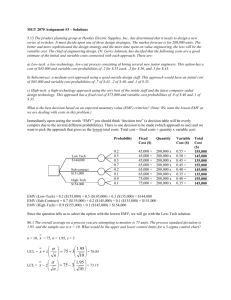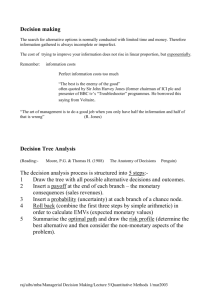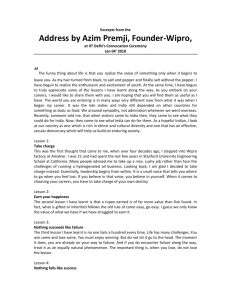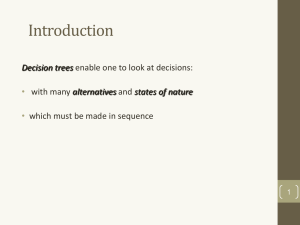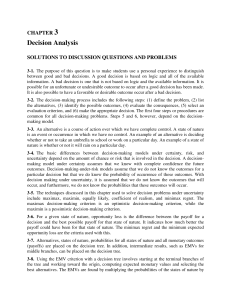Kendall Crab & Lobster Case Summer 2003
advertisement
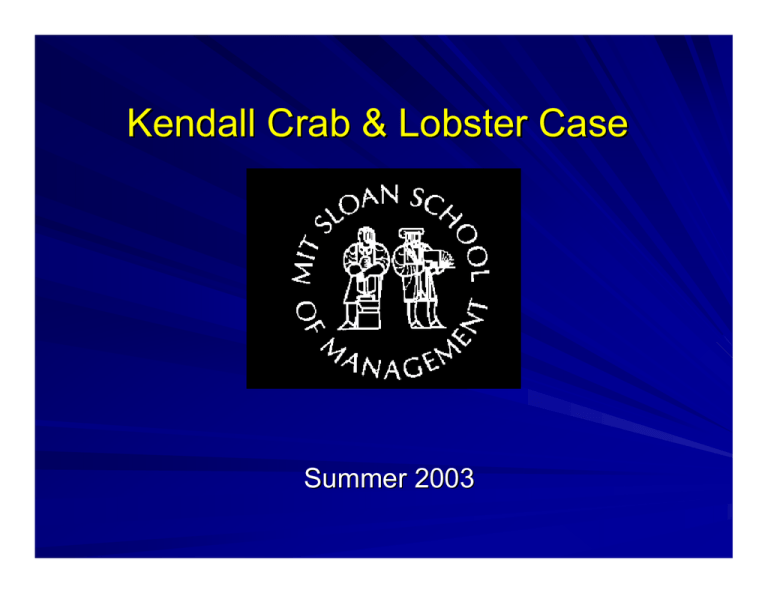
Kendall Crab & Lobster Case
Summer 2003
Why Learn Decision Trees?
Organize limited data
Make assumptions explicit
Learn useful managerial tools
Enhance thinking skills
Make better decisions
Communicate more effectively
Prepare foundation for further study of
simulation and modeling
15.063 Summer 2003
2
Decision Analysis Procedure
List the GOOP
Construct a decision tree
Evaluate the endpoints (outcomes)
Assess probabilities for the branches
“Expect out and fold back” – Backwards
induction
Sensitivity Analysis
Interpretation – what does it mean? What
decisions should we make?
15.063 Summer 2003
3
A (Lobster) Tail of Two Cities
What is the GOOP?
Goals:
Options:
Outcomes:
Probabilities:
Please see the “Kendall Crab and Lobster Case”
in Chapter 1 of the course textbook.
15.063 Summer 2003
4
Trees Help Combine Probabilities
Which would you prefer,
A. win $300 for sure
B. play a gamble in which you have an 80%
chance of winning $450, otherwise $0
Which would you prefer,
C. play a gamble with a 75% chance of
winning $300, otherwise $0
D. play a gamble with a 60% chance of
winning $450, otherwise $0
15.063 Summer 2003
5
Combining Probabilities, continued
Suppose you must choose the second part of
a two-stage gamble now. In the first stage,
there is a 25% chance that you will get $0,
and a 75% chance that you will go on to the
second stage. In the second stage, you can
either
A. win $300 for sure
B. play a gamble in which you have an 80%
chance of winning $450, otherwise $0
You must choose A or B before you know the
first-stage result. Which would you choose?
15.063 Summer 2003
6
Combining Probabilities
$300
$450
.75
.25
.75
.25
.8
$0
$300
24%
$0
$450
.6
.4
56%
.2
$0
59%
$300
$450
.8
.2
$0
$0
15.063 Summer 2003
7
Conditional Probabilities
P=.8 chance of winning $450 if you get to
the second stage is a conditional
probability p(win$450/2nd stage)
The Third Law of Probability (more later):
P(A/B) = P(A and B)/P(B)
P(A and B) = P(A/B) X P(B)
P (winning $450 and getting to second
stage) = .8 X .75 = .6
15.063 Summer 2003
8
Probability Tables
Win first
stage
Lose first
stage
Total
Win second
stage
.75 X .8
= .6
.25 X .8
= .2
.6 + .2
= .8
Lose
second
stage
Total
.75 X .2
= .15
.25 X .2
= .05
.15 + .05
= .2
.6 + .15
= .75
.2 + .05
= .25
.8 + .2 = 1
= .75 + .25
15.063 Summer 2003
9
KCL Sensitivity Analysis
Does considering goodwill costs/demand
cannibalization affect the solution?
No. Canceling the orders and sending coupons is
not part of the optimal tree, even under the more
optimistic scenario considered here.
How sensitive is the solution to the probability the
storm hits Boston (p)?
The optimal solution is to pack and wait as long as
the EMV of this decision is greater than the EMV of
the EPD option. We can easily see this is the case
for all values of p. Thus, the optimal solution stays
the same even if p=1.15.063 Summer 2003
10
Sensitivity Analysis (continued)
How sensitive is the solution to the probability that Logan
will close given a storm (q)?
The optimal solution is to pack and wait as long as the
EMV of this decision is greater than the EMV of the EPD
option: $20250. Thus:
0.5(30000) + 0.5 {q(-15000) + (1-q)30000}>20250
0.5(-45000q)>20250 – 15000 – 15000
-22500q>-9750
q<9750/22500
q<0.433
Thus, the optimal solution remains unchanged for a value
of q as high as 0.433
15.063 Summer 2003
11
What About Risk?
Optimal Strategy
EMV: $25500
Event
Probability
$30000 .5+.5(.8)=0.90
-$27000 (.5)(.2)(.33)=.033
-$9000 (.5)(.2)(.67)=.067
Using EDP
EMV: $20250
Event
Probability
$18000
0.50
$21000
0.25
$24000
0.25
Should Jeff change his strategy?
What would you do?
Is $27,000 a catastrophic loss for KCL? An
embarrassment? A career limiting result?
15.063 Summer 2003
12
Creative Alternatives
Send an early partial shipment from Logan
(UE or competitive alternative)
Select orders for closer/important clients
for ground delivery
…
15.063 Summer 2003
13
Summary
Decision trees are a helpful tool to organize our
thinking and address some failures of intuition
Decision trees provide shared language and
tools to communicate more easily and precisely
Judgment is needed in structuring decisions for
analysis, examining sensitivities, and suggesting
creative alternatives (new options)
Much value comes from sensitivity analysis,
which is part art, part science
15.063 Summer 2003
14
